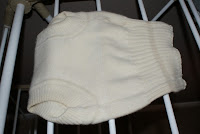Obviously, not all water types are the same and not all machines are the same, but hopefully if you have something similar to my set-up you can have ammonia-free diapers too!
Important points:
- I have an LG front-loading washer with an option for extra water ('water plus'). It adds maybe an extra litre or two of water (not much, but any little bit helps).
- I have a water softener, meaning I don't struggle with hard water issues in my washing routine.
- I use Rockin Green Classic Rock Detergent (1 Tbsp/load).
- I swish poopy diapers in the toilet but don't rinse any other diapers.
- I wash every 2-3 days
- Sometimes I fill the softener dispenser with vinegar for some softening
My Routine:
1. Any cold wash cycle for 5 minutes to soak the clothing. Then stop the cycle completely and move on to step 2. This 5 minute wash soaks the clothes so that when a new cycle starts the clothes are super heavy and tricks the machine into adding max water.
2. Cold wash on delicate cycle with no spin, no detergent, extra water option. This rinses some of the urine out of the diapers and gets off any little pieces of poop off that didn't swish off previously.
3. Hot wash on cotton cycle with medium spin, heavy soil level, detergent, 1/4 cup baking soda, extra water option, extra rinse.
4. Cold wash on delicate, no soap, extra water option.
5. Delicate cycle in dryer or else everything goes out on the line to dry.
There you have it...that's what you can find me doing about every other day at home! Simple and effective!






























